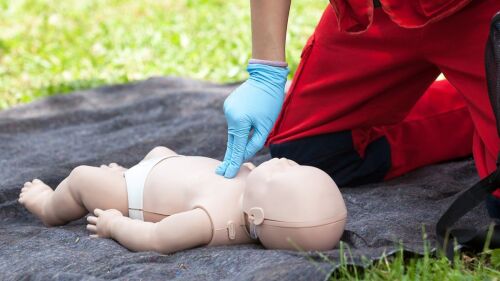By Connor Cameron and Martin Pelletier
Students from Rosalind Franklin University of Medicine and Science Chicago Medical school recently developed and hosted a continuing education clinic for local paramedics highlighting high-risk and low-frequency airway procedures.
Members of the school’s EMS Advocacy organization created an 8-hour event at which 60 participants practiced emergency interventions using live tissue cadavers. Paramedic participants practiced intubation, needle thoracostomy, cricothyroidotomy, suction-assisted laryngoscopy and airway decontamination (SALAD) technique, and simulated pediatric airway management. The participants worked under the guidance of Swedish Hospital emergency medicine residents, Chicago Medical School professors and other advanced practice personnel in a small group, hands-on style.
Live tissue or fresh frozen cadavers are donated bodies that are not preserved. When thawed, the tissue responds nearly identically to that of a living patient and can create a much better clinical experience than most synthetic models. Alternatively, fixed tissue cadavers have been used in training before, but participants found it difficult to perform the maneuvers adequately with preserved tissue. The cadavers were purchased with help from the Rosalind Franklin University anatomy department, and the seminar was held in the on-site cadaver lab. Feedback from participants in an after-action survey indicated that the live tissue cadavers were an excellent model for training.
In addition to cadavers, participants were taught cricothyroidotomy on swine tracheas purchased for the event. They also learned pediatric airway management and SALAD on specialized manikins. This event utilized a flipped classroom style system, in which participants were required to complete an online training module prior to the event. A brief review of the online content was given the day of the event, then the participants were divided into three groups. The three groups cycled through stations where they could practice their skills. Rosalind Franklin University MD, PA and DNP students volunteered to facilitate the event and guide groups from one station to the next.
The results
Feedback from the event was exceedingly positive, with participants rating the event a 9.6/10 on an after-action survey for overall impression of the event. Participants overwhelmingly reported they had enough practice time with each skill to feel comfortable, and they enjoyed the hands-on nature of the event and working with highly skilled instructors.
For future sessions, participants requested intraosseous access practice and chest tube placement as possible skills. For critiques, participants brought up varying EMS system protocols which could exclude some maneuvers taught from field practice.
This event was made possible by the collaboration of many partners, all with the goal of supporting area EMS personnel. Rosalind Franklin University donated time, facilities, and staff to this event as well as empowered the EMS Advocacy student organization. Swedish Hospital Residents donated their time to teach the participants, and medical supplies were donated by Rush University Medical Center.
EMS Advocacy organization President Martin Pelletier stated, “This event not only served an educational purpose, but it also served to bolster morale in the EMS profession considering all the challenges we have seen this year. We want to empower our paramedic colleagues and foster a sense of interprofessionalism; something that Rosalind Franklin University values.”
Based on the positive feedback received, EMS Advocacy is planning on hosting this event again next year.
About the author
Connor Cameron is a first-year medical student at Rosalind Franklin University’s Chicago Medical School, as well as president of Phi DE Beta Tau and president of the school’s EMS Advocacy organization.
Martin Pelletier is the former EMS Advocacy President at Rosalind Franklin University’s Chicago Medical School.




















